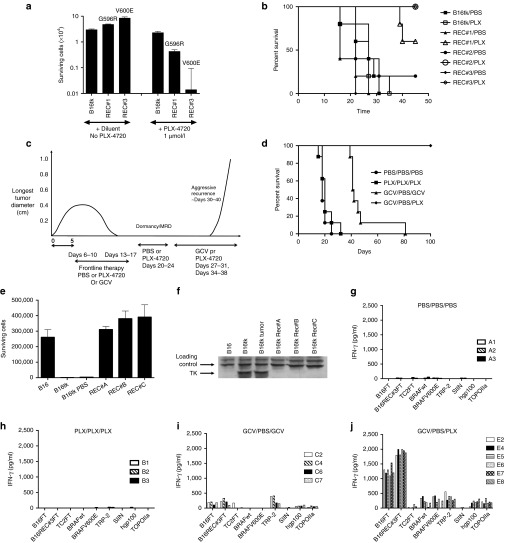Figure 6.
BRAF mutant melanoma recurrences can be treated by chemotherapy. (a) Parental B16tk, B16tk REC#1 (BRAFG596R), B16tk REC#3 (BRAFV600E) cells were plated (104 cells/well in triplicates) in diluent or medium containing PLX-4720 at 1 µmol/l. Seventy-two hours later, cells were washed in PBS, 3×, trypsinised and counted. (b) C57Bl/6 mice were seeded with B16tk or B16tkREC #1, #2, or #3 tumors subcutaneously on day 1. On days 6–10, 13–17, and 20–24, tumor bearing mice were treated with PBS or with PLX-4720 (30 mg/kg/day). Survival of mice in each treatment group (n = 5) in which euthanasia was necessary due to tumor reaching 1.0 cm diameter by day 45 is shown. At day 45, surviving mice bearing B16tkREC #1, #2, or #3 tumors, and treated with PLX-4720, had tumors of longest diameter 0, 0, 0.2 cm (REC #1); 0, 0.2, 0.4, 0.6, and 0.6 cm (REC #2); and 0, 0, 0, 0, and 0 cm (REC #3) respectively. (c) C57BL/6 mice seeded with B16tk tumors 5 days previously were treated with PBS, PLX-420 at 30 mg/kg/day or with 100 µl GCV i.p. at 50 mg/kg for 5 consecutive days, followed by 2 days rest, followed by five further consecutive injections of PBS, PLX-4720, or GCV (d6-10 and 13–17) (first cycle). Mice were then injected daily i.p. with PBS or with PLX-4720 on days 20–24 (second cycle). Finally, mice were injected daily i.p. with GCV or PLX-4720 on days 27–31 and 34–38 (third cycle). (d) Survival of mice (n = 7/8 per group) treated sequentially with first, second, and third cycles of treatment as shown and as described in c. (e) 104 cultured B16 cells (not transduced with the HSVtk gene) or cultured B16tk cells were grown for 96 hours in GCV (5 µg/ml) in triplicate cultures. In addition, the same number of cells from an explanted B16tk primary tumor treated in vivo with PBS; or 3 B16tk REC tumors, REC A, REC B, and REC C, explanted from mice which had failed second line GCV therapy (following GCV-induced initial regressions and MRD) in c, were similarly treated in vitro with GCV. The number of surviving cells is shown. (f) Western blot for the expression of the HSVtk protein in cultured B16 or cultured B16tk cells or in explanted B16tk primary tumor cells from a mouse treated in vivo with PBS; or from the three B16tk REC tumors REC A, B, and C, explanted from mice which had failed second line GCV therapy (following GCV-induced initial regressions and MRD) in c. (g–j) Splenocyte/LN cultures from (g) three different mice treated with PBS (first cycle) and PBS (second cycle) (no survivors for third cycle); (h) three mice treated with PLX-4720/PLX-4720 (first and second cycles, no survivors for third cycle); (i) four mice treated with GCV/PBS/GCV (first, second, and third cycles); or (j) from six mice treated with GCV/PBS/PLX-4720 (first, second, and third cycles); were screened for IFN-γ secretion following re-stimulation with freeze thaw cell lysates of parental B16 cells; B16tk REC#3 (BRAFV600E) cells; TC2 cells; or with peptide epitopes from wild-type BRAF, mutated BRAFV600E, murine TRP-2, Ovalbumin SIINFEKL, hgp-100 or murine TOPO-IIα as described in Materials and Methods.

